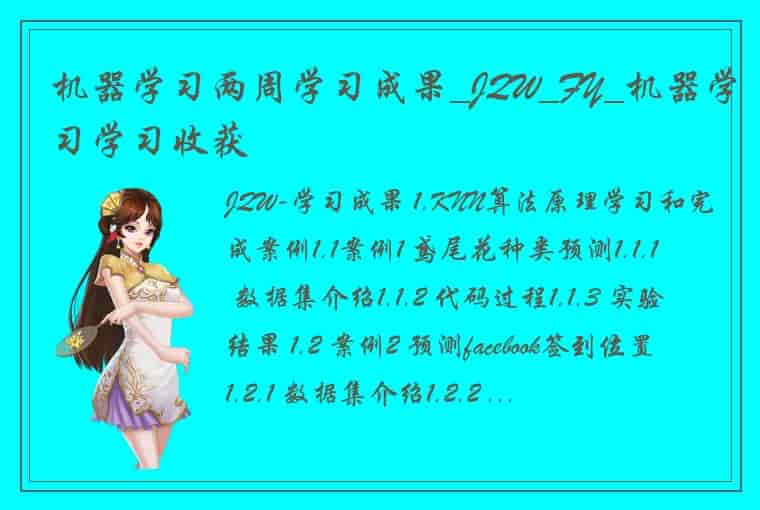JQW-学习成果 1.KNN算法原理学习和完成案例1.1案例1 鸢尾花种类预测1.1.1 数据集介绍1.1.2 代码过程1.1.3 实验结果 1.2 案例2 预测facebook签到位置1.2.1 数据集介绍1.2.2 代码过程1.2.3 实验结果 2. 线性回归原理学习和案例完成2.1 案例 波士顿房价预测2.1.1 数据介绍2.2.2 代码过程2.2.3 实验结果 3.逻辑回归原理学习和案例实现3.1案例 癌症分类预测-良/恶性乳腺癌肿瘤预测3.1.1 数据介绍3.1.2 代码过程3.3.3 实验结果 4.决策树原理学习和案例实现4.1 案例:泰坦尼克号乘客生存预测4.1.1 数据介绍4.1.2 代码过程4.3.3 实验结果 5.聚类原理学习和案例实现5.1 案例:探究用户对物品类别的喜好细分降维5.1.1 数据介绍5.1.2 代码过程5.3.3 实验结果 6.其它成果 1.KNN算法原理学习和完成案例 1.1案例1 鸢尾花种类预测 1.1.1 数据集介绍
Iris数据集是常用的分类实验数据集,由Fisher, 1936收集整理。Iris也称鸢尾花卉数据集,是一类多重变量分析的数据集。关于数据集的具体介绍:
1.1.2 代码过程 from sklearn.datasets import load_iris from sklearn.model_selection import train_test_split from sklearn.preprocessing import StandardScaler from sklearn.neighbors import KNeighborsClassifier # 1.获取数据集 iris = load_iris() # 2.数据基本处理 # x_train,x_test,y_train,y_test为训练集特征值、测试集特征值、训练集目标值、测试集目标值 x_train, x_test, y_train, y_test = train_test_split(iris.data, iris.target, test_size=0.2, random_state=22) # 3、特征工程:标准化 transfer = StandardScaler() x_train = transfer.fit_transform(x_train) x_test = transfer.transform(x_test) # 4、机器学习(模型训练) estimator = KNeighborsClassifier(n_neighbors=9) estimator.fit(x_train, y_train) # 5、模型评估 # 方法1:比对真实值和预测值 y_predict = estimator.predict(x_test) print("预测结果为:\n", y_predict) print("比对真实值和预测值:\n", y_predict == y_test) # 方法2:直接计算准确率 score = estimator.score(x_test, y_test) print("准确率为:\n", score) 1.1.3 实验结果 1.2 案例2 预测facebook签到位置 1.2.1 数据集介绍大赛的目的是预测一个人想签入到哪个地方。对于本次比赛的目的,Facebook的创建一 个人造的世界,包括位于10公里的10平方公里超过10万米的地方。对于一个给定的坐标,你的任务是返回最有可能的地方的排名列表。数据制作出类似于来自移动设备的位置的信号,给你需要什么与不准确的,嘈杂的价值观复杂的真实数据工作一.番风味。不-致的和错误的位置数据可能破坏,如Facebook入住服务经验。 数据介绍:将根据用户的位置,准确性和时间戳预测用户正在查看的业务。
train.csv,test.csv row_id:登记事件的ID xy:坐标 准确性:定位准确性 时间:时间戳 place_id:业务的ID,这是您预测的目标
1.2.2 代码过程 # 1、获取数据集 facebook = pd.read_csv("./data/FBlocation/train.csv") 2.基本数据处理 # 2.基本数据处理 # 2.1 缩小数据范围 facebook_data = facebook.query("x>2.0 & x<2.5 & y>2.0 & y<2.5") # 2.2 选择时间特征 time = pd.to_datetime(facebook_data["time"], unit="s") time = pd.DatetimeIndex(time) facebook_data["day"] = time.day facebook_data["hour"] = time.hour facebook_data["weekday"] = time.weekday # 2.3 去掉签到较少的地方 place_count = facebook_data.groupby("place_id").count() place_count = place_count[place_count["row_id"]>3] facebook_data = facebook_data[facebook_data["place_id"].isin(place_count.index)] # 2.4 确定特征值和目标值 x = facebook_data[["x", "y", "accuracy", "day", "hour", "weekday"]] y = facebook_data["place_id"] # 2.5 分割数据集 x_train, x_test, y_train, y_test = train_test_split(x, y, random_state=22) # 3.特征工程--特征预处理(标准化) # 3.1 实例化一个转换器 transfer = StandardScaler() # 3.2 调用fit_transform x_train = transfer.fit_transform(x_train) x_test = transfer.fit_transform(x_test) # 4.机器学习--knn+cv # 4.1 实例化一个估计器 estimator = KNeighborsClassifier() # 4.2 调用gridsearchCV param_grid = {"n_neighbors": [1, 3, 5, 7, 9]} estimator = GridSearchCV(estimator, param_grid=param_grid, cv=5) # 4.3 模型训练 estimator.fit(x_train, y_train) # 5.模型评估 # 5.1 预测值输出 y_pre = estimator.predict(x_test) print("预测值为:\n", y_pre) # 5.2 score score = estimator.score(x_test, y_test) print("准确率为:\n", score) # 5.3 其他评价指标 print("最好的模型:\n", estimator.best_estimator_) print("最好的结果:\n", estimator.best_score_) print("整体模型结果:\n", estimator.cv_results_) 1.2.3 实验结果2. 线性回归原理学习和案例完成 2.1 案例 波士顿房价预测 2.1.1 数据介绍
3.逻辑回归原理学习和案例实现 3.1案例 癌症分类预测-良/恶性乳腺癌肿瘤预测 3.1.1 数据介绍
(1)699条样本,共11列数据,第一列用语检索的id,后9列分别是与肿瘤相关的医学特征,最后一列表示肿瘤类型的数值。 (2)包含16个缺失值,用”?”标出。
3.1.2 代码过程 import pandas as pd import numpy as np from sklearn.model_selection import train_test_split from sklearn.preprocessing import StandardScaler from sklearn.linear_model import LogisticRegression import ssl ssl._create_default_https_context = ssl._create_unverified_context # 1.获取数据 names = ['Sample code number', 'Clump Thickness', 'Uniformity of Cell Size', 'Uniformity of Cell Shape', 'Marginal Adhesion', 'Single Epithelial Cell Size', 'Bare Nuclei', 'Bland Chromatin', 'Normal Nucleoli', 'Mitoses', 'Class'] data = pd.read_csv("https://archive.ics.uci.edu/ml/machine-learning-databases/breast-cancer-wisconsin/breast-cancer-wisconsin.data", names=names) data.head() # 2.基本数据处理 # 2.1 缺失值处理 data = data.replace(to_replace="?", value=np.NaN) data = data.dropna() # 2.2 确定特征值,目标值 x = data.iloc[:, 1:10] x.head() y = data["Class"] y.head() # 2.3 分割数据 x_train, x_test, y_train, y_test = train_test_split(x, y, random_state=22) # 3.特征工程(标准化) transfer = StandardScaler() x_train = transfer.fit_transform(x_train) x_test = transfer.transform(x_test) # 4.机器学习(逻辑回归) estimator = LogisticRegression() estimator.fit(x_train, y_train) # 5.模型评估 y_predict = estimator.predict(x_test) y_predict estimator.score(x_test, y_test) 3.3.3 实验结果 4.决策树原理学习和案例实现 4.1 案例:泰坦尼克号乘客生存预测 4.1.1 数据介绍在泰坦尼克号和titanic2数据帧描述泰坦尼克号上的个别乘客的生存状态。这里使用的数据集是由各种研究人员开始的。其中包括许多研究人员创建的旅客名单,由Michael A. Findlay编辑。提取的数据集中的特征是票的类别,存活,乘坐班,年龄,登陆,home.dest,房间,票,船和性别。
4.1.2 代码过程 import pandas as pd import numpy as np from sklearn.feature_extraction import DictVectorizer from sklearn.model_selection import train_test_split from sklearn.tree import DecisionTreeClassifier, export_graphviz # 1、获取数据 titan = pd.read_csv("http://biostat.mc.vanderbilt.edu/wiki/pub/Main/DataSets/titanic.txt") # 2.数据基本处理 # 2.1 确定特征值,目标值 x = titan[["pclass", "age", "sex"]] y = titan["survived"] # 2.2 缺失值处理 # 缺失值需要处理,将特征当中有类别的这些特征进行字典特征抽取 x['age'].fillna(x['age'].mean(), inplace=True) # 2.3 数据集划分 x_train, x_test, y_train, y_test = train_test_split(x, y, random_state=22) # 3.特征工程(字典特征抽取) # 特征中出现类别符号,需要进行one-hot编码处理(DictVectorizer) x.to_dict(orient="records") 需要将数组特征转换成字典数据 # 对于x转换成字典数据x.to_dict(orient="records") # [{"pclass": "1st", "age": 29.00, "sex": "female"}, {}] transfer = DictVectorizer(sparse=False) x_train = transfer.fit_transform(x_train.to_dict(orient="records")) x_test = transfer.fit_transform(x_test.to_dict(orient="records")) # 4.决策树模型训练和模型评估 # 决策树API当中,如果没有指定max_depth那么会根据信息熵的条件直到最# 终结束。这里我们可以指定树的深度来进行限制树的大小 # 4.机器学习(决策树) estimator = DecisionTreeClassifier(criterion="entropy", max_depth=5) estimator.fit(x_train, y_train) # 5.模型评估 ret=estimator.score(x_test, y_test) ret y_pre = estimator.predict(x_test) print(y_pre) 4.3.3 实验结果5.聚类原理学习和案例实现 5.1 案例:探究用户对物品类别的喜好细分降维 5.1.1 数据介绍
order_products__prior.csv:订单与商品信息
字段:order_id, product_id, add_to_cart_order, reorderedproducts.csv:商品信息
字段:product_id, product_name, aisle_id, department_idorders.csv:用户的订单信息
字段:order_id,user_id,eval_set,order_number,….aisles.csv:商品所属具体物品类别
字段: aisle_id, aisle 5.1.2 代码过程 import pandas as pd from sklearn.decomposition import PCA from sklearn.cluster import KMeans from sklearn.metrics import silhouette_score # 1.获取数据 order_product = pd.read_csv("./data/instacart/order_products__prior.csv") products = pd.read_csv("./data/instacart/products.csv") orders = pd.read_csv("./data/instacart/orders.csv") aisles = pd.read_csv("./data/instacart/aisles.csv") # 2.数据基本处理 # 2.1 合并表格 # 2.1 合并表格 table1 = pd.merge(order_product, products, on=["product_id", "product_id"]) table2 = pd.merge(table1, orders, on=["order_id", "order_id"]) table = pd.merge(table2, aisles, on=["aisle_id", "aisle_id"]) # 2.2 交叉表合并 table = pd.crosstab(table["user_id"], table["aisle"]) # 2.3 数据截取 table = table[:1000] # 3.特征工程 — pca transfer = PCA(n_components=0.9) data = transfer.fit_transform(table) # 4.机器学习(k-means) estimator = KMeans(n_clusters=8, random_state=22) estimator.fit_predict(data) # 5.模型评估 silhouette_score(data, y_predict) 5.3.3 实验结果 6.其它成果阅读内容
《机器学习》(周志华)部分章节《Python机器学习基础教程》(Sarah Guido)部分章节推荐系统、深度学习、交通预测相关的论文
 1.本站遵循行业规范,任何转载的稿件都会明确标注作者和来源;2.本站的原创文章,会注明原创字样,如未注明都非原创,如有侵权请联系删除!;3.作者投稿可能会经我们编辑修改或补充;4.本站不提供任何储存功能只提供收集或者投稿人的网盘链接。 1.本站遵循行业规范,任何转载的稿件都会明确标注作者和来源;2.本站的原创文章,会注明原创字样,如未注明都非原创,如有侵权请联系删除!;3.作者投稿可能会经我们编辑修改或补充;4.本站不提供任何储存功能只提供收集或者投稿人的网盘链接。 |

